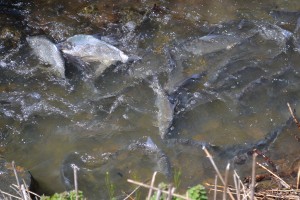
BERLIN – Spawning shad created a stir in Ocean Pines this week as they struggled to reach the South Gate Pond.
Drivers stopped their cars and area residents gathered around ditches leading to the South Gate Pond Monday as hundreds of gizzard shad took advantage of recent rainfall to make their way to the pond to spawn.
“Instinct tells them to move upstream to spawn,” said Brett Coakley, a fisheries biologist with the Maryland Department of Natural Resources (DNR). “That’s where fish will stack up. It’s like waiting in line in an amusement park.”
Several residents said Monday afternoon they had been watching the fish traverse the ditches for hours. While hundreds made their way into the pond, many, tangled in rocks or exhausted from their journey, lay dead through the ditch along Ocean Parkway. Area residents Pat Allen and James “Poncho” Waters were among the crowd watching the fish struggle to reach the pond.
“Everybody was standing here and we stopped to see what they were looking at,” Waters said.
Though he wasn’t there, Coakley, who had seen photos and spoken with bystanders, said the fish were gizzard shad. He says they are native to Maryland and live in brackish water throughout the Chesapeake Bay’s drainage areas.
“We have an abundance of gizzard shad throughout Maryland,” Coakley said.
In spring, they ascend streams to lay their eggs. Coakley said the fish were attracted to the outflow at the South Gate Pond created by recent rains.
“They gravitate toward current,” he said. “The area received a lot of rainfall so there’s more than the normal amount of water coming out of the output pipe which the gizzard shad are attracted to.”
Coakley said that while there were always some gizzard shad in the South Gate Pond, it was not a species of fish DNR particularly wanted to see there.
“They’re not a fish that people typically fish for and they don’t have any eating value,” he said.
Because DNR maintains the South Gate Pond for public fishing, Coakley said he would rather see bass and crappies in it.
“Gizzard shad can overpopulate a pond very easily,” he said.
Though some of the residents gathered around the South Gate Pond this week used nets to help the floundering shad make it from the ditch to the pond, Coakley said it was natural for a certain percentage of fish to die during a spawning run.
“That’s just part of nature,” he said, adding that it was illegal for anyone to transport fish without a permit.
Coakley says the rush of gizzard shad into the South Gate Pond could continue for another week or even two, depending on the amount of precipitation the area sees. Late April temperatures have triggered spawning and the excess water flowing from the pond is attracting the fish to it.
“When the outflow ceases to be an attractant, they’ll stop,” Coakley said.
For more information on gizzard shad, visit DNR’s website, www.dnr2.maryland.gov.

